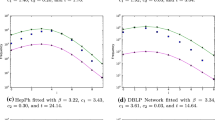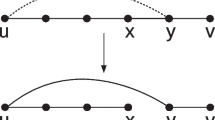Abstract
In this paper, we study “robust” dominating sets of random graphs that retain the domination property even if a small deterministic set of edges are removed. We motivate our study by illustrating with examples from wireless networks in harsh environments. We then use the probabilistic method and martingale difference techniques to determine sufficient conditions for the asymptotic optimality of the robust domination number. We also discuss robust domination in sparse random graphs where the number of edges grows at most linearly in the number of vertices.
Similar content being viewed by others
References
Alon, N. and Spencer, J. (2008). The Probabilistic Method. Wiley Interscience, 2008.
Bollobás, B. (2001). Random Graphs. Cambridge University Press.
Clark, L. and Johnson, D. (2011). The Independent Domination Number of a Random Graph. Discuss. Math. Graph Theory, 31, 129–142.
Du, H., Ding, L., Wu, W., Kim, D., Pardalos, P. M. and Willson, J. (2013). Connected Dominating Set in Wireless Networks. In: Pardalos, P., Du, DZ., Graham, R. (eds) Handbook of Combinatorial Optimization. Springer, New York.
Glebov , R., Liebenau, A. and Szabó, T. (2012). On the Concentration of the Domination Number of the Random Graph. SIAM Journal on Discrete Mathematics, 29, 1186–1206.
Wang, B. and Xiang, K. (2009). On \(k-\)tuple Domination of Random Graphs. Appl. Math. Lett., 22, 1513–1517.
Wieland, B. and Godbole, A. P. (2001). On the Domination Number of a Random Graph. Electronic Journal of Combinatorics, 8, #R37, 1–13.
Wu, J. and Li. H. (2000). Domination and its Applications in Ad Hoc Wireless Networks with Unidirectional Links. IEEE International Conference on Parallel Processing 2000, 1–9.
Zou, F., Li, X., Kim, D. and Wu, W. (2008). Construction of Minimum Connected Dominating Set in \(3-\)Dimensional Wireless Network. Wireless Algorithms, Systems and Applications, 5258, 134–140.
Acknowledgements
I thank Professors Rahul Roy, C. R. Subramanian and the referee for crucial comments that led to an improvement of the paper. I also thank IMSc and IISER Bhopal for my fellowships.
Author information
Authors and Affiliations
Corresponding author
Ethics declarations
Data availibility
Data sharing not applicable to this article as no datasets were generated or analysed during the current study.
Additional information
Communicated by B V Rajarama Bhat.
Appendix
Appendix
Standard Deviation Estimate: Let \(Z_i, 1 \le i \le t\) be independent Bernoulli random variables satisfying \({\mathbb {P}}(Z_i = 1) = p_i = 1-{\mathbb {P}}(Z_i = 0).\) If \(W_t = \sum _{i=1}^{t} Z_i\) and \(\mu _t = {\mathbb {E}}W_t,\) then for any \(0< \eta < \frac{1}{2}\) we have that
For a proof of (34), we refer to Corollary \(A.1.14,\) pp. \(312,\) Alon and Spencer (2008).
\( \underline{Montonicity of u_n(x)}\): The function \(u_n(x):= \frac{\log (nx)}{|\log (1-x)|}\) has a derivative
where
is the binary entropy function and logarithms are natural throughout. If \(x > \frac{1}{2},\) then \(H(x) - x\log {n} \le 1-\frac{\log {n}}{2} <0\) for all \(n \ge 4.\) The numerator \(H(x)-x\log {n}\) has derivative \(\log \left( \frac{1}{x}-1\right) - \log {n} < 0\) for all \(x > \frac{1}{n+1}.\) Thus for \(\frac{\lambda }{n}< x < \frac{1}{2}\) and \(\lambda > 1\) we use \((1-x)|\log (1-x)| <x\) to get that \(H(x)-x\log {n}\) is bounded above by
which is strictly less than zero if \(\lambda > e.\)
Rights and permissions
Springer Nature or its licensor (e.g. a society or other partner) holds exclusive rights to this article under a publishing agreement with the author(s) or other rightsholder(s); author self-archiving of the accepted manuscript version of this article is solely governed by the terms of such publishing agreement and applicable law.
About this article
Cite this article
Ganesan, G. Robust domination in random graphs. Indian J Pure Appl Math (2023). https://doi.org/10.1007/s13226-023-00374-6
Received:
Accepted:
Published:
DOI: https://doi.org/10.1007/s13226-023-00374-6




